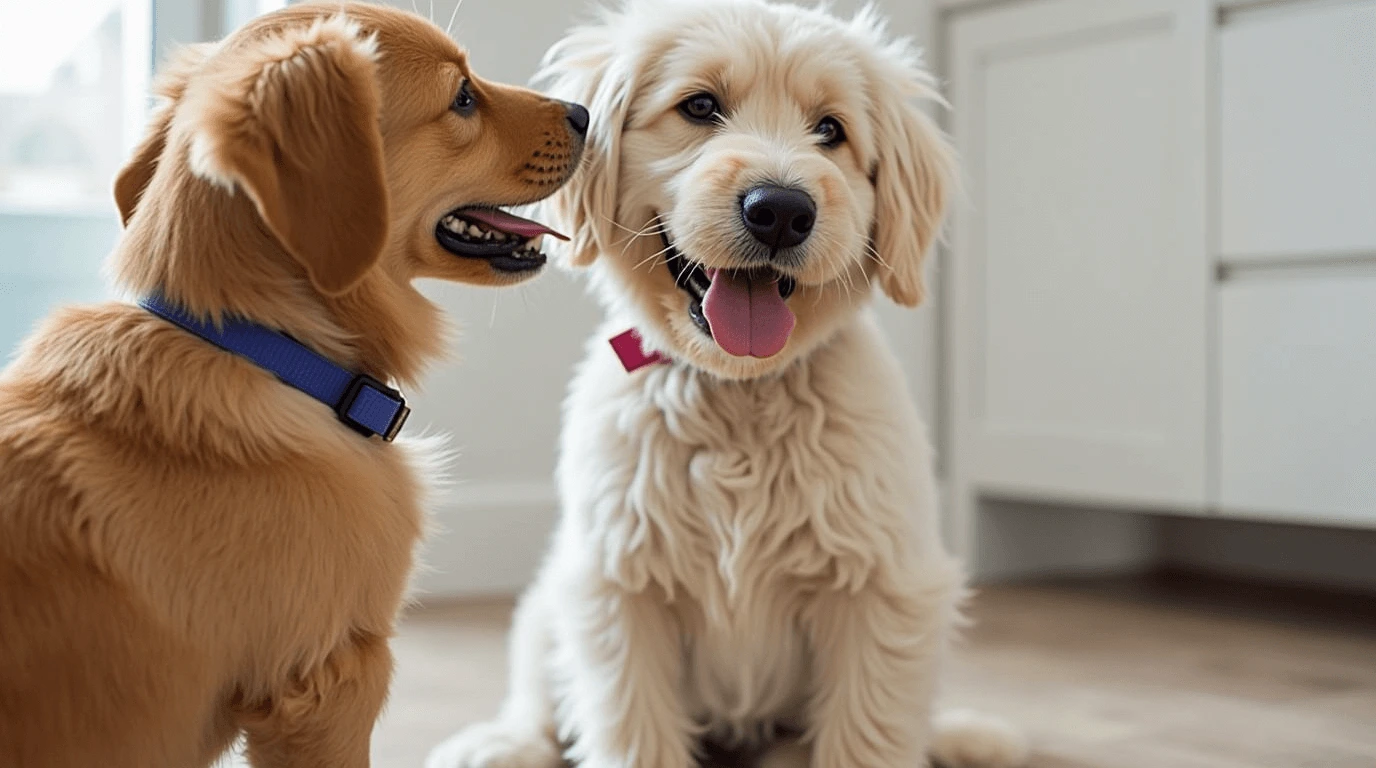Imagine turning your pet into a vital support system. Service dog training at home is more than a journey. It’s a deep bond that can change your life. The Americans with Disabilities Act (ADA) lets you train your own service dog.
Training a service dog at home is a chance to form a strong bond with a four-legged friend. They can help with physical or mental health issues. The journey starts in your home.
Training needs dedication, patience, and a focus on building important skills. Your home is the first place your service dog learns. They’ll learn basic commands and special tasks.
Key Takeaways
- Service dog training at home is legally recognized under the ADA
- The entire training process can take up to 2 years to complete
- Owner training can save significant costs compared to professional services
- Consistent training and socialization are critical for success
- Service dogs must meet specific behavioral standards in public spaces
- The right breed and individual dog temperament are crucial for effective training
Understanding Service Dog Training Requirements and Legal Guidelines
Getting into service dog training means knowing the law and what’s needed. As someone who wants to train service dogs, you must understand the rules for these special animals.
ADA Regulations for Service Dogs
The Americans with Disabilities Act (ADA) sets clear rules for service dogs. These rules are key for anyone looking to get certified in service dog training. Here are the main points:
- Service dogs must be trained to do specific tasks for their handler’s disability
- No official certification is needed by federal law
- Businesses can only ask two specific questions about service dogs:
- Is the dog a service animal required for a disability?
- What task has the dog been trained to perform?

Key Behavioral Requirements
A professional service dog trainer must make sure dogs meet important behavior standards:
| Behavioral Requirement | Specific Expectations |
|---|---|
| Public Conduct | Must remain under handler’s control |
| Elimination | No inappropriate urination or defecation |
| Temperament | Non-disruptive in public spaces |
Handler Qualifications and Responsibilities
The handler is crucial in service dog training. They must have a qualifying disability and be able to work well with their service dog. They need to train the dog, keep its skills sharp, and make sure it behaves well in public.
While there’s no need for official certification, handlers should get thorough training. This prepares both dog and handler for everyday challenges.
Benefits of Service Dog Training at Home
Choosing in-home service dog training has many advantages. It helps you bond with your dog and meets their unique needs. Unlike traditional methods, home training lets you connect deeply with your service dog.
Home training offers more than just convenience. Studies show it’s very effective:
- One-on-one training sessions can increase effectiveness by 30% compared to group classes
- 70% of service dog handlers report a stronger bond when training in a familiar environment
- Home training can reduce anxiety for both the dog and handler
- Up to 50% time savings compared to traditional training facilities
Cost is also a big plus for in-home training. Professional service dogs can cost between $15,000 to $30,000. Training your own dog at home can save you thousands. It also lets you create a support system tailored to your needs.
“Training a service dog at home allows for real-life skill application, improving skill retention by 40%.”
Your home is the best place to teach your dog new skills. Dogs learn better in places they know well. This way, your service dog can easily help you every day.
Essential Equipment and Training Tools for Home Training
Starting a service dog training program at home needs the right tools. The right equipment makes your dog’s learning journey smoother.
Good training uses the right tools to teach and reward your dog. Experts say picking the right gear is key for both you and your dog.
Training Aids and Equipment
Here are some must-haves for your service dog training:
- Durable training leashes with precise control features
- Comfortable harnesses that support training movements
- Clickers for precise behavior marking
- Treat pouches for easy reward delivery
- Interactive toys for engagement
Reward Systems and Motivators
Positive reinforcement is key in service dog training. Here are some motivational tools:
- Pro-Treats (100% liver treats with under 3 calories)
- Remote reward training devices
- Varied treat types to maintain interest
- Verbal praise and physical affection
Documentation and Progress Tracking Tools
Keeping track of your dog’s progress is important. Use these tools:
- Training logs and progress charts
- Video recordings of training sessions
- Digital tracking apps
- Performance assessment checklists
Dogs learn best in 10-15 minute sessions, 2-3 times a day. The “Rule of 5” helps by breaking training into short parts.
Foundational Obedience Training Basics
Service dog training starts with basic commands. These are the building blocks of a well-behaved service animal. Learning these commands online is key, and it’s all about positive training.
Basic obedience commands are crucial for a service dog. They include:
- Sit
- Stay
- Down
- Heel
- Come
Timing is everything in service dog training. Studies say dogs need feedback in 1 to 1.7 seconds to learn. Training should be short, lasting 10-15 minutes,service dog training at home to keep dogs focused and avoid getting frustrated.
| Training Method | Effectiveness | Recommended Age |
|---|---|---|
| Positive Reinforcement | Most Effective | 6-7 weeks |
| Clicker Training | High Effectiveness | Puppy Stage |
| Reward-Based Training | Consistent Results | Early Socialization |
Online service dog training needs patience and a grasp of how dogs learn.service dog training at home It’s important to practice in different places. This ensures your dog can follow commands anywhere.
Service Dog Training at Home: Step-by-Step Process
Training a service dog at home needs dedication, patience, and a clear plan. This journey has many important steps. Each step turns a regular dog into a special support dog. Knowing each stage helps you train a service dog that meets your needs.
Socialization Foundation
The first step in training a service dog at home is socialization.service dog training at home You’ll introduce your dog to many places, sounds, and experiences. Important socialization steps include:
- Introducing varied environments (parks, streets, indoor spaces)
- Exposing the dog to different people and age groups
- Practicing calm behavior in stimulating situations
- Gradually increasing complexity of social interactions
Mastering Basic Commands
Getting basic control is key in service dog training at home. Your dog needs to be very obedient and quick to respond. Focus on teaching basic commands like:
- Sit and stay
- Come when called
- Heel and walk beside you
- Leave it and drop it
Advanced Task Training
The final stage is teaching specific tasks for disabilities.service dog training at home Precision and consistency are very important here. Tasks can be anything from reminding you to take medicine to providing physical support.
Getting help from a professional trainer is very helpful. They know how to handle challenges in training. Especially if you’re training a psychiatric service dog, they can give you strategies to overcome problems.
Teaching Specialized Service Tasks and Commands
Teaching a service dog is all about precision and patience. A good trainer knows that service dogs do more than just sit. They break down hard tasks into easy steps,service dog training at home fitting the needs of people with disabilities.
Some tasks a service dog might learn include:
- Deep pressure therapy for anxiety
- Reminding to take medicine
- Helping with moving around
- Clearing rooms for people with PTSD
- Alerting to health issues
Many dogs struggle with advanced training. About 70% of dogs don’t make it through full training. This shows how important it is to pick the right dog and use the right training methods.
When teaching special tasks, consider these points:
- Know what the disability needs
- Make hard tasks simpler
- Use positive rewards
- Practice in different places
- Make sure the dog does the task well
Golden Retrievers and Labrador Retrievers are great for service work.service dog training at home They love to learn and obey well. A good training program uses the dog’s strengths and the handler’s needs.
Using rewards right away helps dogs connect actions with good results. A calm training space helps your service dog learn tasks well and with confidence.
Public Access Training and Socialization Techniques
Training a service dog for public places needs patience, consistency, and careful exposure. When looking for service dog training near me, you’ll find public access training is key. It helps create a dependable working partner.
Public areas pose special challenges for service dogs.service dog training at home Your training should aim to build great focus, self-control, and flexibility in various settings. Good service dog training programs focus on slow, controlled exposure to different places.
Environmental Exposure Training
Good environmental training means introducing dogs to different places and situations step by step. Here are some important strategies:
- Begin with quiet, controlled areas
- Slowly add more complex settings
- Practice in busier places
- Use positive reinforcement
Behavioral Standards in Public Spaces
Service dogs must show perfect behavior in public.service dog training at home This includes:
- Keeping calm
- Ignoring distractions
- Quickly responding to handler commands
- Staying focused on their main task
Common Challenges and Solutions
Service dog handlers face specific challenges during public access training.service dog training at home Consistent practice and professional advice can help solve these problems well.
Successful public access training needs about 200-300 hours of hard work and commitment.
Keep in mind, only 50-60% of dogs finish comprehensive service dog training. Your hard work and systematic approach will greatly boost your success chances.
Task-Specific Training for Different Disabilities
Training a service dog needs a deep understanding of the unique needs of people with disabilities. A good service dog training program must be customized to meet the specific challenges of each handler.
Each disability requires a unique approach to service dog training.service dog training at home The trainer must create strategies for specific tasks related to different health conditions:
- Mobility Assistance: Supporting individuals with physical limitations
- Psychiatric Support: Helping those with mental health challenges
- Medical Alert: Detecting critical health changes
- Sensory Assistance: Supporting individuals with hearing or vision impairments
For mobility assistance, service dogs learn important skills. They can retrieve objects, open doors, and help with walking.service dog training at home Psychiatric service dogs do tasks like stopping anxiety episodes, giving deep pressure therapy, and setting boundaries in crowded places.
Medical alert dogs are trained to detect small changes in their handler’s body chemistry. These amazing animals can:
- Alert to potential seizures
- Detect blood sugar level changes for diabetic handlers
- Recognize early signs of panic attacks
- Identify potential allergic reactions
The Americans with Disabilities Act sees service dogs as vital support animals. They are trained to perform specific tasks for people with disabilities.service dog training at home Training a service dog needs patience, consistent practice, and a deep understanding of the handler’s needs.
Monitoring Progress and Maintaining Skills
Service dog training online needs regular checks and smart plans. About 75% of dog owners use structured training with skill checks. Keeping your service dog’s skills sharp is key.
It’s important to track how well your dog is doing. Training sessions should be 5 to 10 minutes long each day. This helps your dog learn and remember better. service dog training at home They can show progress quickly and learn new things fast.
Training Milestones and Assessments
Make a detailed plan to track your dog’s skills. Studies show that only about 10% reach their goals without written plans. Keep a record of each skill and task your dog learns. Your checks should measure how well they do in different places.
Ongoing Practice and Skill Maintenance
Table of Contents
Keeping your dog’s skills up takes hard work and smart practice. More than 60% of trainers say adding play to training helps. It keeps your dog confident and interested. Short, regular training sessions work better than long ones.

